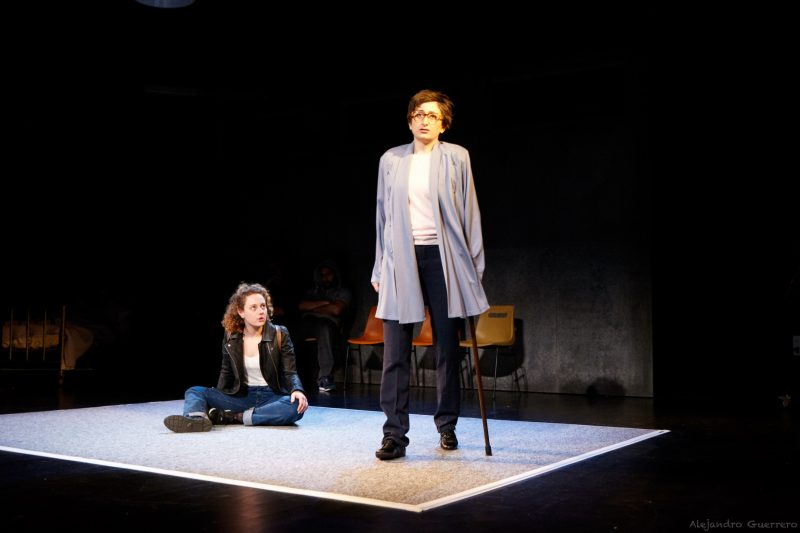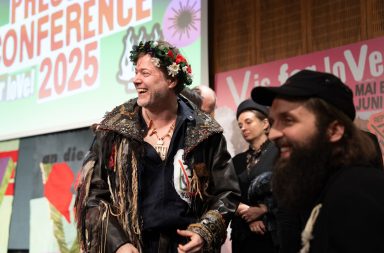by Diana Nechit
From June 20 to 29, 2025, Sibiu International Theater Festival (FITS) will open its curtains to French culture in a poetic and creative arch titled “The French Season”. Thirteen projects originating from mainland France will grace the FITS stage with performances that combine tradition, innovation, critical thinking, and visual enchantment. Twelve French theatre companies performing both indoors and outdoors, new publications, translations, and stars present on the Walk of Fame, come to reinforce, for the umpteenth time, the strong cultural and theatrical ties between the two spaces through new playwrights, urban performances, poetry, and some of the most original street acrobatics.
The striking aspect of this French selection is, above all, its deliberate diversity: from short plays to spectacular frescoes, from documentary drama to pure acrobatic poetry, from tears to unbridled comedy, it illustrates the breadth of writing for contemporary theater. FITS thereby becomes a pluralistic artistic ecosystem, where textual finesse coexists with bold gestural expression. Such diversity allows us, the spectators, to enjoy a theatrical experience that is sensory, thought-provoking, playful, and inclusive.
The French artists coming to Sibiu are far from “unknown” in the French cultural scene: Alexis Michalik, considered one of the most popular playwrights of his generation, has won several Molière Awards, notably for Le Porteur d’Histoire, Edmond and Intra Muros, which has been a resounding success since its premiere in 2017. His accessible and deeply human narrative style has succeeded in engaging a wide audience with high artistic standards, becoming a living bridge between the contemporary stage and the tradition of the great storytellers.
David Geselson, respectively, has earned recognition for his creations that intertwine autobiography, documentary fiction, and political engagement. Doreen and Le Silence et la Peur (Silence and Fear) resonate through their evocative power and formal subtlety. Created as part of the Avignon Festival, The Neanderthal Project continues this delicate interplay between the personal and the universal, revealing how theatre can offer new perspectives on what humanity is.
At the heart of the indoor selection, festivalgoers are tempted by two major productions from two well-known French artists: A History of Humanity / Neanderthal, a show co-produced by Compagnie Lieux Dits and Avignon Festival and directed by David Geselson (June 20, 21). The performance is a theatrical “investigation” into our origins through a poetic and political fresco. Can we make the past speak by trying to decode the signs of the present? The performance traces the footsteps of Neanderthal Man through the journey of four geneticists, set against the backdrop of the Israeli-Palestinian conflict and the dissolution of the former Yugoslavia. The performance is crafted as an intimate and anthropological palimpsest in which the author and director draw upon science, memory, personal narratives, and authentic documents to revisit the origins of humanity.

Then, on June 24 and 25, the unmissable Alexis Michalik presents Intra Muros, which may bring the concept of “theater in prison” to FITS for the very first time – a performance that will be accompanied by a special conference. Without intending to reveal too many details about this performance, it contains all the “ingredients” of a theater history course, or better yet, a course on the dramatic arts, enriched with reflections on the therapeutic powers of theater, in every sense of the word. In an actual prison setting, Richard, an ambitious director, leads a theater workshop for all “institution retirees”. The only problem is that only two of the most violent inmates show up at the workshop! The performance brings together the voices of prisoners and artists in a vibrant and deeply human huis-clos, through which Michalik reintroduces a powerful plea for the redemptive power of art to the public. A regular presence at the Sibiu festival, the French playwright and director will also receive a star on the Walk of Fame this year.

In the public eye, the French stage is turning into a real creative, diverse, and colorful carnival. From the choreographic poetry of Transe Express (Life Spiral / DNA) to the tender and burlesque humor of Cie Petit Monsieur (How to Set Up a Tent) and through the immersive experiences proposed by Cie Kervan, who evokes the magic of nomads through Mirage et Haliad (June 23-24) in an aesthetic inspired by fairy tales and the poetry of the elements. In the performances of Elixir, Zalatai, and Rekupertou, the audience is invited to journey through a world where circus, object theater, music, and puppetry become defining features of a thoroughly contemporary theatrical landscape. As such, Zalatai’s Bal(les) becomes a rhythmic, juggling-filled fresco of love. Paris Benares presents their sacred cows, Rekupertou their unusual instruments, and Caramantran giant animals that transform the city into a tender and dreamlike jungle.
France has more than extensive experience in the field of street theater, not only artistically, but also in terms of organization and festivals, producing an impressive number of some of the most prolific and original artists. To give a more descriptive example, Bruno Blandy, the founder of the Rekupertou Company has a complex musical background, handling the guitar, bass, percussion, steel drum, and vocals with equal dexterity. During his artistic travels around the world, from Mexico to South Korea, he met and performed alongside famous artists: Luther Alison, Toots and the Maytals or Youri Buenaventura. He has also been part of numerous collective musical experiences, engaging with genres such as rock, blues, jazz, French, Oriental, Caribbean, and African music.
The French presence also unfolds in more intimate spaces that combine reading with the transmission of cultural heritage, poetry, and theater. Once again, this year, the Micro-Folie Sibiu digital platform invites audiences on an immersive journey through the treasures of French museums, while also offering many other surprises. Théâtre de la Ville alongside Teatro della Pergola and TNRS offers the audiences the well-known “poetic consultations”, lyrical moments suspended in space and time, in which actors deliver verses to an audience, forging a bond of intimate complicity with each listener.

There will also be news from the publishing world, as Éric-Emmanuel Schmitt, a beloved author among fans of play readings, will be present again this year with a “first reading” of his new work, Mozart & Mozart, which blends erudition with humor and a strong dose of humanity. As every year, French playwriting maintains a strong presence in FITS’s publishing program, and starting this year, ULBS Publishing House will launch a new collection dedicated to highlighting French dramaturgy. Given the international success of Kuliabin’s production In the Solitude of Cotton Fields, we will launch a volume of translations featuring the most important works of playwright Bernard-Marie Koltès.
The diversity and richness of this program stand as testimony to a multifaceted French theatrical presence that is demanding, yet never exclusive; inventive, yet attuned to the pressing urgencies of an increasingly complex reality. It is a generous kind of theater, remarkable in its ability to speak to audiences of all kinds. I have tried to find a poetic conclusion to this article, which is meant to be, above all, an invitation to a French showcase, and the only possible one is that of the friendship and organic relationship that exists between the two cultural and theatrical spaces. We find ourselves, spectators and participants alike, faced with a constellation of aesthetics, voices, and gestures that seek and find each other, balancing between introspection and brilliance, between commitment and pure delight. Between introspection and sharp “incursions” into the occasionally brutal reality, the French presence at FITS 2025 is a testament to a lively, vibrant, and diverse theater, one in constant dialogue with otherness.
But what if theater were nothing more than the journey of artists from one space to another, where the “light” of some enhances the “brilliance” of others?
Translation: Andreea-Anca Sin; Credit photo: ”Between walls / Intra Muros”, Christophe Vootz


